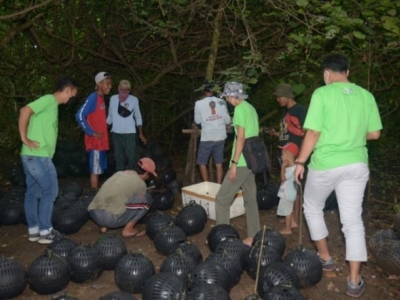Sustainable Crab Cultivation Using Crab Ball in Bantul

Mangrove crab (Scylla serrata) is one type of fishery commodity that can be cultivated. Mangrove crabs are coomonly found in brackish waters overgrown with mangrove plants. Mangrove crab is favored by the public, considering its delicious taste with high nutritional content. However, the Minister of Maritime Affairs and Fisheries has determined mangrove crabs as one type of fish (crustaceans) prohibited from being caught in spawning conditions and below the size suitable for catching. To meet the needs of mangrove crabs safely and sustainably,Universitas Negeri Yogyakarta (UNY) together with the Center for Competitiveness Development (Pusdaing) of the Ministry of Villages, Development of Disadvantaged Regions and Transmigration (Kemendes PDTT) of the Republic of Indonesia implemented a crab ball technology test in the Mangrove Forest on Baros Beach. located in Baros Hamlet, Tirtohanggo, Kretek, Bantul.
According to the Vice-Rector for Planning and Cooperation of UNY, Prof. Siswantoyo this activity aims to socialize and implement a model of using appropriate technology for crab balls to increase crab production and the competitiveness of aquaculture farmers.
Head Village of Tirtohargo, Sugiyamto said that before there was cooperation assistance from UNY, Baros residents searched for crabs using traditional nets or traps. Still, the results were not optimal and potentially harmed the crab ecosystem because they were seasonal. "It's more profitable to cultivate this crab through crab balls," said Sugiyamto.
This activity was initiated by Karang Taruna Baros and has produced 4 crabs per kilogram. Sugiyamto hopes that the crab harvest can reach 2 or even 1 crap per kilogram in the future. He has total commitment to run the crap cultivation accordingly, just as UNY guidance.
UNY Lecturer Tri Atmanto, M.Si explained that a crab ball is a container for cultivating crabs from seeds until they are ready to harvest. The advantages of this crab ball include reducing competition in finding food for crabs so that the developed crabs' size can be bigger. Besides that, it can also become a tourist attraction for crab cultivation because one crab ball is only set with one crab to ensure its growth rate.
The Coordinator of Bumdes Tirtohanggo Setiyo explained that crab balls could meet the local needs of crabs because of environmental support, such as the Opak-Oya river estuary, which experiences high tides during the dry season, which is the best time to harvest crabs.
This crab cultivation collaboration also received attention from the Pusdaing Kemendes PDTT, which held a Focus Group Discussion (FGD) on Monday (14/2) at UNY. Head of Pusdaing Helmiati, M.Si, said that crab cultivation using crab balls has worked well and can be used as a reference. "Pusdaing can provide recommendations to provide a locus for local governments in need," she said.
In 2022, Pusdaing will again cooperate with UNY to empower villages with other potentials that suit the community's needs but do not rule out cooperation in the crab sector to add value to the crabs produced. According to her, at Pusdaing, four things can be the leading performance indicators: creativity and innovation, appropriate technology, high technology, and digital technology. Hermiati hopes there will be many new ideas from UNY in collaboration with Pusdaeng this year. The UNY working group also attended the FGD on planning and cooperation, lecturers, the leadership of Tirtohanggo Kretek Village, Bantul, and Digital Ambassadors of the Ministry of Village from DIY, Magelang, and Boyolali. This activity is one of UNY's efforts in the sustainable development agenda in partnership, reducing hunger and poverty. (Dedy, Tj. Lak)

